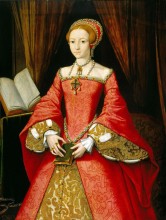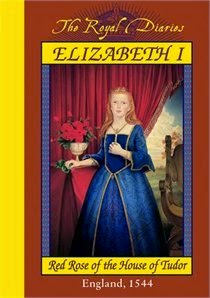Viewing: Blog Posts Tagged with: NaNoEdMo, Most Recent at Top [Help]
Results 1 - 5 of 5
Blog: But What Are They Eating? (Login to Add to MyJacketFlap)
JacketFlap tags: Kathryn Lasky, Elizabeth I, Swan, FoodFic, Eel, Red rose of the House of Tudor, The Royal Diaries, Add a tag
Blog: OUPblog (Login to Add to MyJacketFlap)
JacketFlap tags: History, VSI, scotland, British, Very Short Introductions, scottish history, elizabeth I, Mary Queen of Scots, rab houston, catholicism, imprisonment, treason, *Featured, James I, calvinism, John Knox, Protestantism, abdication, VSI online, Arts & Humanities, Scotland: A Very Short Introduction, fox hunt, Auld alliance, Lochleven Castle, Add a tag
Mary Stewart became Queen of Scots aged only 6 days old after her father James V died in 1542. Her family, whose name was anglicised to Stuart in the seventeenth century, had ruled Scotland since 1371 and were to do so until the death of Queen Anne in 1714. Raised in France from 1548, she married the heir to the French throne (1558) and did not come to Scotland until after he died in 1561.
The post A royal foxhunt: The abdication of Mary Queen of Scots appeared first on OUPblog.
Blog: OUPblog (Login to Add to MyJacketFlap)
JacketFlap tags: elizabeth, royalty, This Day in History, elizabeth I, tudor, throne, British history, *Featured, higher education, this day in world history, Queen Elizabeth I, british monarchy, boleyn, hatfield, bess—ruled, History, UK, queen, lawn, catherine, Add a tag
This Day in World History
November 17, 1558
Elizabeth I becomes England’s Queen
 The twenty-five-year-old princess was seated beneath an oak tree on the lawn of her home, Hatfield House. Suddenly, several courtiers hurried across the lawn until they reached her location, stopped, and bowed. The queen has died, they told her. You are now queen of England. Young Elizabeth, it is said, fell to her knees and quoted a line from Psalm 118: “It is the Lord’s doing, and it is marvelous in our eyes.”
The twenty-five-year-old princess was seated beneath an oak tree on the lawn of her home, Hatfield House. Suddenly, several courtiers hurried across the lawn until they reached her location, stopped, and bowed. The queen has died, they told her. You are now queen of England. Young Elizabeth, it is said, fell to her knees and quoted a line from Psalm 118: “It is the Lord’s doing, and it is marvelous in our eyes.”
Elizabeth I, daughter of King Henry VIII by his second wife, Anne Boleyn, had reached the throne by a more circuitous path than most monarchs. Her father’s first wife, Catherine of Aragon, had born a daughter, Mary, but no son. Frustrated, Henry had broken with the Catholic Church and formed the Church of England so he could divorce Catherine and marry Anne Boleyn. After she bore Elizabeth and a stillborn son, Boleyn was beheaded for adultery—a trumped-up charge—when Elizabeth was but three. Henry then married Jane Seymour, who finally produced a male heir, the prince Edward.
Much of Elizabeth’s childhood and youth were difficult and spent away from court because her father rejected her. When he died and Edward came to the throne, she soon fell under suspicion of complicity in a plot to overthrow him. Her careful response to questions saved her. When Edward died, Mary came to the throne. She tried to restore the Catholic Church, leading to several Protestant rebellions, which led the queen to throw her half-sister into the Tower of London for a few months and eventually send her to Hatfield under house arrest.
Everything changed on that November day, however. Two months later, on January 15—a day chosen in part for its astrological promise—she had her official coronation at Westminster Abbey. Elizabeth I, called Gloriana—and Good Queen Bess—ruled for nearly 45 years and gave her name to an age.
“This Day in World History” is brought to you by USA Higher Education.
You can subscribe to these posts via RSS or receive them by email.
Blog: OUPblog (Login to Add to MyJacketFlap)
JacketFlap tags: History, UK, Current Events, England, marriage, weddings, royalty, queen, William, elizabeth I, monarchy, Editor's Picks, *Featured, royal wedding, will and kate, kate middleton, helen berry, the castrato and his wife, wills and kate, Add a tag
By Helen Berry
The purpose of British royalty is for people to look at them. Successful monarchs throughout history have understood this basic necessity and exploited it. Elizabeth I failed to marry, and thus denied her subjects the greatest of all opportunities for royal spectacle. However, she made up for it with a queenly progress around England. As the house guest of the local gentry and nobility, she cleverly deferred upon her hosts the expense of providing bed, breakfast and lavish entertainment for her vast entourage, in return for getting up close and personal with her royal personage. It was not enough to be queen: she had to be seen to be queen. Not many monarchs pursued such an energetic itinerary or bothered to visit the farther-flung corners of their realm again (unless they proved fractious and started a rebellion). But then, most of Elizabeth’s successors over the next two hundred years were men, who could demonstrate their iconic status and personal authority, if need be, upon the battlefield (which was no mere theory: as every schoolboy or girl ought to know, George II was the last monarch to British lead troops in battle).
Towards the end of the seventeenth century, improvements in print technology and increasing freedom of the press provided a new way for British people to look at their king or queen. The rise of a mass media in Britain was made possible by the lapse of the Press Act in 1695 (the last concerted attempt by the government to censor newspapers). The Constitutional Settlement of 1689 had determined that Divine Right was not the source of the king’s authority, rather, the consent of the people through parliament. So, during the next century, from the very moment that the monarchy had started to become divested of actual power, royal-watching through the press increasingly became a spectator sport. Essentially harmless, the diverting obsession with celebrity royals proved the proverbial wisdom inherited from ancient Rome that ‘beer and circuses’ were a great way to keep people happy, and thus avoid the need to engage them with the complex and unpleasant realpolitik of the day.
It was during the long reign of George III (1760-1820) that newspapers truly started to become agents of mass propaganda for the monarchy as figureheads of that elusive concept: British national identity. The reporting of royal births, marriages and deaths became a staple of journalistic interest. Royal households had always been subject to the gaze of courtiers, politicians and visiting dignitaries, but via the press, this lack of privacy now became magnified, with public curiosity extending to the details of what royal brides wore on their wedding days. George III made the somewhat unromantic declaration to his Council in July 1761: ‘I am come to Resolution to demand in Marriage Princess Charlotte of Mecklenburg Strelitz’. She was a woman ‘distinguished by every eminent Virtue and amiable Endowment’, a Protestant princess from an aristocratic German house who spoke no English before her wedding, but no matter: she was of royal blood and from ‘an illustrious Line’.
The first blow-by-blow media account of the making of a royal bride ensued, starting with the employment of 300 men to fit up the king’s yacht in Deptford to fetch Charlotte from across the Channel. Over the course of the summer in an atmosphere of anticipation at seeing their future Queen, London printsellers began cashing in, with pin-up portraits of the Princess ‘done from a Miniature’ at two shillings a time. Negotiations towards the contract of marriage were followed closely by the newsreading public during August and were concluded mid-month to general satisfaction. Finally, after two weeks of wearisome travel, on September 7th, the Princess arrived at Harwich. The St. Jam
Blog: Jessica Burkhart (Login to Add to MyJacketFlap)
JacketFlap tags: prize winners, NaNoEdMo, prize winners, NaNoEdMo, Add a tag
We have winners in Beckie Weinheimer's contest!
Will.... Miss Information and Britlitfantwin email your addresses to me ASAP? Send those to jessica [at] jessicaburkhart [dot] com. Congratulations!
Thank you for stopping by, Beckie. Your interview was so much fun! :)
Onto other things, March is the start of...NaNoEdMo! I signed up over at the site to pledge to spend 50 hours in March editing a novel. Want to join me? Em promised to sign up and I'm looking for more to join in. The group is a LOT smaller than NaNoWriMo, but it's growing.
Okay, I'm off to research. Anyone going to NaNoEdMo with me?





Hey winners. Yeah to you! I'm Beckie Weinheimer, author of CONVERTING KATE, please let Jessica know if you have something specific you want signed in your book and please spell the name you want the book dedicated to! Happy Tuesday!
Beckie Weinheimer
Hey, I'm officially registered as EmH. This is going to be fun...
All right! I'll look you up to see if there's a buddy system on there. Not sure...